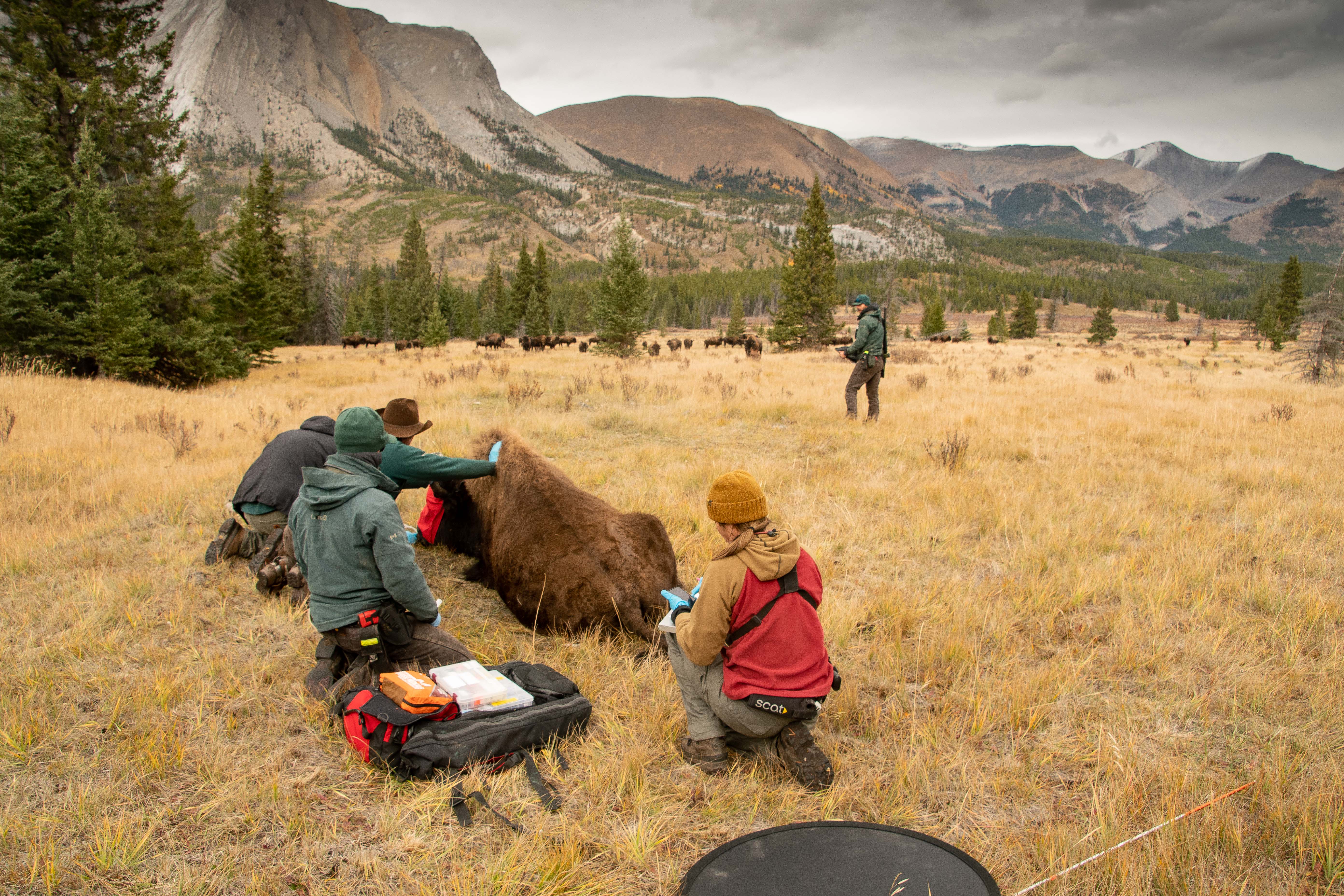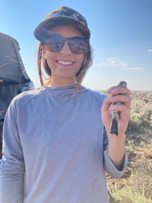""I am incredibly honored to receive both the Don and Judy Legerski UW Teton Graduate Scholars in Biodiversity Fellowship and the Biodiversity Institute Graduate Student Excellence Grant. This generous funding supports my work in furthering the scientific understanding of biodiversity by assessing mechanisms underlying western forest bird declines. This funding also supports the integration of community science with other scientific long-term monitoring efforts to help address…"
Biodiversity Graduate Student Research Enhancement Grants
The Biodiversity Institute seeks annual proposals that enhance biodiversity research efforts of UW graduate students, because graduate students are a major engine of biodiversity research and future leaders of conservation.
Successful conservation of biological diversity requires both basic and applied research to better inform current and future policy decisions. The Biodiversity Institute (BI) is providing grants to enhance or expand ongoing graduate student research at the University of Wyoming that addresses how biodiversity is generated, maintained, or restored.
All of the funds that will be distributed are available because of the generous contributions of donors. Donors choose to give to the BI because of the quality of the research we support, and the high-quality communication of that research to the public. As the BI strives to increase the amount of funding available to students in the future from our donors in Wyoming, the Rocky Mountain region, and around the world, we require that proposals communicate the value of the research to the public. Awardees will be required to present their research to the public in a BI-sponsored Science Cafe, as well as 1) volunteer at a BI-sponsored outreach event or 2) develop your own community engagement activity (a menu of BI outreach options is available here.) Awardees are required to attend a science communication training, tentatively scheduled for November 5 and 6, 2025, 6 - 8 pm.
We have two grant options. Please read through the options carefully before submitting your application. Requests for more than one award will be accepted, but must be budgeted separately.
Funding is available from May 1, 2025 to August 31, 2026 (or until date of graduation, whichever comes first). Awards cannot be extended.
Timeline:
Feb 14 RFP announced
March 24 Proposals due
April 16 Awards announced
May 1 Funding begins
November 5 & 6, 6-8 pm Required science communication training for awardees. Awardees must attend both sessions.
August 31, 2026 Last day of funding period
October 1, 2026 Final reports due
2025 Grant Recipients
Olivia Beauedette
Department of Zoology and Physiology
“Bottom-up influences on juvenile fitness in a suite of declining songbirds”
Despite underpinning many of the fitness outcomes observed within ecology, fundamental information on food preferences, resultant fitness benefits, and the distribution of those key foods is lacking for many wildlife species of concern. A more complete understanding of interactions between these factors is needed to address wildlife population declines and habitat management, especially in the face of rapid environmental change. Sagebrush songbirds, which include the Brewer’s sparrow (Spizella breweri), sagebrush sparrow (Artemiziospiza tridentata), and sage thrasher (Oreoscoptes montanus), nest within increasingly altered sagebrush habitat and are Species of Greatest Conservation Need in Wyoming. Juvenile stages are defined by high rates of mortality and can function as a bottleneck within songbird populations, which reinforces the importance of examining factors influencing juvenile survival. Nestling morphological traits carryover to influence survival once birds leave their nests and are likely influenced by the food types, rates, and amounts fed to nestlings. Therefore, diet might be a missing link driving trait development and subsequent fitness outcomes in our focal species.
Walker Bensch
Wyoming Natural Diversity Database
“Does elk trampling alter the nesting bee community at Fossil Butte National Monument"
Soil quality is of great importance for ground nesting bees to establish nests and overwinter successfully. Prior research has shown that soil compaction can reduce the diversity of bees capable of creating nests. Some research has connected cattle stocking density in pastures to changes in the bee community, in part due to their trampling of the soil. Combine this with the fact that cattle change vegetation density and floral diversity, and it is easy to see how large grazing animals are ecosystem engineers for bees. No studies, however, have extended this concept to other large ungulates, like elk. At Fossil Butte National Monument, the West Green River elk herd migrates through the park annually. A previous study found that during hunting season, elk congregate in the park to avoid surrounding land where hunting is permitted. This creates the unique opportunity to investigate how the increased trampling and grazing activity of elk in the park affects nesting resources, floral resources, and overall bee diversity compared to reduced elk activity on surrounding land. In doing so, we will expand our knowledge of the ecology of ground nesting bees while providing valuable insights to park management at Fossil Butte National Monument.
Caroline Brose
Department of Botany
Program in Ecology and Evolution
“Evolutionary consequences of adaptive introgression and polyploidy; Salix as a system for understanding generation and maintenance of species diversity"
Understanding the patterns and processes that underly the creation and maintenance of species diversity is one of the most important questions in evolutionary biology. Knowledge of these patterns and processes are necessary for predicting evolutionary and ecological consequences of changes in species’ distribution and local extirpation. In plants, hybridization, subsequent introgression, and polyploidy are essential processes that can aid in either the creation or breakdown of species boundaries. Arctic and alpine willows (Salix sp.) are known for frequent natural hybridization and polyploidy, making them an excellent system for studying the effects of these processes on species diversity. Using a combination of genomic, morphological, and environmental data from populations of sympatric Salix species across their ranges, it is possible to identify the roles that hybridization and polyploidy play in the maintenance or breakdown of species boundaries in taxonomically complex groups.
Daniel Coles
Department of Botany
"A Flora of the Bighorn Mountains: Sheridan, Big Horn, Johnson, and Washakie counties, Wyoming"
My research project is a comprehensive floristic inventory of the Bighorn Mountains in north-central Wyoming. The primary goal is to document the plant diversity, distribution, and ecological patterns across the range, with a particular focus on alpine and subalpine ecosystems. This work contributes to the Rocky Mountain Herbarium by providing high-quality voucher specimens and associated data and supports broader regional and continental-scale studies like the GLORIA Initiative. Through detailed field surveys, I aim to better understand species composition, biogeographic patterns, and floristic affinities.
Lindsey Gapinski
Wyoming Cooperative Fish and Wildlife Research Unit
Program in Ecology and Evolution
"Understanding biodiversity by assessing mechanisms underlying avian population declines"
Breeding bird populations are declining across North America, and among them, western forest birds are experiencing some of the most rapid and widespread losses. The underlying causes of western forest bird declines remain understudied and thus poorly understood. Without insight into what is driving these losses, wildlife stewards are limited in their abilities to develop targeted conservation strategies. Through my Ph.D. research, I aim to test alternative hypotheses and disentangle the mechanisms underlying widespread declines in forest bird populations across the inter-mountain west, including some of the most iconic and ecologically rich landscapes in the United States, such as the Greater Yellowstone Ecosystem. I leverage the unique strengths of large-scale, long-term bird monitoring datasets to assess how environmental changes like forest loss, shifting climate patterns, and altered disturbance regimes are affecting birds at multiple taxonomic levels. The specific goals of my work are to identify primary mechanisms associated with declines, evaluate how these patterns vary spatially, and determine which species may be facing increased threats.
Alexis Hollander
Program in Ecology and Evolution
"Comparing modern freshwater mussel populations to an arch"
Freshwater mussels are cryptic yet critical components of aquatic ecosystems. They provide habitat structure to other plants and invertebrates, serve as prey for fish, mammals, and birds, and improve water quality through filtration. The White heelsplitter is a mussel native to the Belle Fourche River in Wyoming, including within Devils Tower National Monument. The last assessment of this mussel population was conducted in 2014, which is a length of time almost as long as their lifespan of 12 years. The goal of my project is to resurvey this population 11 years later and update the population status in Devils Tower. Some of the questions we are asking are whether the population has grown or declined since 2014, what is the age structure of the population, and if we can compare modern mussel growth to shells we have in the archaeology record. Our findings will help provide information to managers to conserve White heelsplitters in the state.
Meredith Journey
Department of Zoology and Physiology
Wyoming Cooperative Fish and Wildlife Research Unit
"Exploring impacts of increased glacial sediment on alpine lake zooplanton ecology"
As a result of climate induced glacial recession, glacial-fed alpine lakes are increasing globally. Alpine lakes are often nutrient limited and have low primary productivity due to short ice-free seasons, however increased glacial sediment input could increase lake nutrient concentrations with unknown repercussions for native zooplankton communities. This research aims to understand how glacial recession and changes to snow phenology will alter alpine lake ecology by describing the limnology and zooplankton ecology of glacial and non-glacial lakes in the Wind River and Teton Ranges. This work addresses our need to better understand how climate change is impacting vital high elevation pristine ecosystems.
Renee Lile
Department of Zoology and Physiology
Program in Ecology and Evolution
"Investigating the community composition and diet of bats in the Black Hills of South Dakota following white-nose syndrome invasion"
By identifying shifts in bat populations and changes in insect prey composition, my research will provide critical insights into the ecological impacts of WNS in western South Dakota, as well as broader trends in WNS ecology and bat populations across the western USA. This will enable land managers to develop effective, data-driven conservation strategies, supporting a management approach that targets prey species and their habitats at the lower trophic levels, and enhancing ecosystem and bat health in the region.
Lindsey Mitchell
Program in Ecology and Evolution
Wyoming Cooperative Fish and Wildlife Research Unit
"Understanding biodiversity by assessing mechanisms underlying avian population declines"
The loss of biodiversity can reduce ecosystem stability and function and impair regulatory ecosystem services on which many species rely (Cardinale et al. 2012). When the drivers of population declines and localized extinctions are known, practitioners can minimize losses to ecosystems by adjusting management practices or changing policy. However, the mechanisms underlying biodiversity loss often remain unclear, resulting in an incomplete understanding of how biodiversity is maintained and complicating efforts to mitigate losses. The main objective of my work is to further the scientific understanding of biodiversity maintenance by assessing mechanisms underlying widespread declines in forest birds of the inter-mountain west, including those within the Greater Yellowstone Ecosystem.
Emily Shertzer
Department of Zoology and Physiology
Program in Ecology and Evolution
"Identifying molt and movement during sensitive periods for understudied passerines"
Sagebrush songbirds only spend about a quarter of the year on their breeding grounds in Wyoming. However, even though the non-breeding period makes up most of their annual cycle, we still don’t know where these small songbirds migrate, overwinter, or grow in their new set of feathers each year (a process called molting). In addition, we don’t know how flexible those migratory strategies are; for example, do birds in the same breeding population migrate to the same wintering areas? Are individuals themselves flexible across years? My research aims to answer these questions. I am using very small tags (0.29 g) called light-level geolocators to track the migratory routes and overwintering movements of Brewer’s sparrows, sagebrush sparrows, and sage thrashers that breed in the Greater Yellowstone Area, and to identify where along these routes the birds are molting. The support from the Biodiversity Institute will allow me to complete analysis on this project and to share my results with other scientists and the public.
Marguerite Trost
Department of Botany
"A community-powered, first comprehensive vascular inventory of the Kootenai National Forest, Northwest Montana"
This project develops a vascular flora of the Kootenai through intensive botanical student training and collective community efforts. The Kootenai National Forest (KNF), 2.2 million acres of public lands in a remote, often-overlooked corner of Montana, comprises one of the largest stretches of the Rocky Mountains still lacking adequate baseline representation in herbaria (Fig. 1). Its latitudinal zone, six heterogeneous mountain ranges, intersection of floristic regions, altered fire history, and tapestry of land use history mean I am documenting numerous range extensions and unique community assemblages, including mesic forest coastal disjuncts, deciduous conifer (larch) stands, narrowly endemic species, and novel invasive species.
Lauren Wetterau
Department of Zoology and Physiology
"Effects of red squirrel middens on biodiversity and species occupancy in the Greater Yellowstone Ecosystem"
The North American red squirrel acts as an ecosystem engineer through its larder-hoarding behavior and creation of distinctive mound-like structures known as middens, which are large, localized accumulations of cones, seeds, and woody debris.
Charles Williams
Department of Zoology and Physiology
Program in Ecology and Evolution
"Patterns of spatiotemporal thermal heterogeneity in the Upper Snake River; WY: Implications for Snake River Cutthroat Trout"
This project examines how spatial and temporal variations in water temperature shape thermal habitats in a 43 km stretch of the Upper Snake River, Wyoming, critical habitat for the native Snake River Cutthroat Trout. By combining stationary temperature loggers with high-resolution, longitudinal temperature profiling using a Fast Limnological Automated Measurement (FLAMe) system, the research will model fine-scale thermal dynamics and identify key areas of thermal stress as well as locations that function as thermal refuge. The goal is to better understand how changing thermal conditions impact biodiversity and community stability, while providing resource managers with actionable data. Through community float trips, classroom engagement, and public outreach, the project also emphasizes collaborative science and knowledge sharing.
2024 Grant Recipients
Mary De Aquino
Jordan Von Egger
Reina Galvan
Spencer Holtz
Olivia Leviton
Maria Paula Rodriguez
Erik Schoenborn
Megan Szojka
2023 Grant Recipients
Alyssa Baldwin
Michael Castaño
Audrey Lindsteadt
Hailey Mount
Samantha Poratti
Amy-Marie Storey
2022 Grant Recipients
Annabella Helman
Bridger Huhn
Leo Khasoha
Hailey Mount
Yasaman Shakeri
Luke Wilde
Katie Davis
Tana Verzuh
Rachel Arrick
Albert Mason
2021 Grant Recipients
Tanner Hoffman
Christie Wildcat
Jeff Baldock
Bailey Kirkland
Courtney Garrity
Bridger Huhn
Douglas Kamaru
Christina M. Sluka
Jordan Von Eggers
2020 Grant Recipients
Sienna Wessel
Jimena Golcher-Benavides
Katherine Gura
Mel Torres
Aaron Enriquez
Dedan Ngatia
Laura Gomez Murillo
“I am honored to receive the 2022 Richard Baldes Native American Excellence Fund award from the Biodiversity Institute. I hope to inspire other Native American students to go to college and acquire critical training to help advance tribal sovereignty."
Albert Mason - Masters Student, 2022 Grant Recipient

Tana Verzuh (right to the bison, PhD candidate in PiE) and others take vital information from a bison before releasing it as a part of Banff National Park's bison reintroduction program. Photo by Karsten Heuer.
The Biodiversity Graduate Student Research Enhancement Grant Program supports:
- Student-designed and driven research that 1) improves our understanding of how biodiversity is generated, maintained, or restored and how it impacts ecosystem services and 2) provides effective means of communicating the value of biodiversity research to diverse audiences including assessment of the communication’s effectiveness;
- Summer, half-academic year, or full-academic year graduate stipends and tuition;
- Travel and supplies that support the project.
Successful proposals:
- Enhance and expand ongoing biodiversity research by graduate students;
- Be clearly articulated and compelling by appropriately framing biodiversity research questions or hypotheses and include a brief, accessible description of methods;
- Provide a mechanism to 1) communicate the findings in a way that connects the research across the state of Wyoming and the Rocky Mountain region, and especially communities beyond Laramie, as well as to local residents if the research is performed in another region, and 2) evaluate effectiveness of the communication.
Eligibility:
-
Grants are available to any masters or doctoral student in good standing at the University of Wyoming at the time the award is made.
-
Graduate students must continue to be enrolled, with good standing, at the University of Wyoming throughout the duration of their proposal timeline. Funding is available from May 1, 2024 to August 31, 2025 (or until the date of graduation, whichever comes first). Funding cannot be extended.
-
Research must have ongoing support in the form of existing resources to the student or advisor, access to appropriate equipment, and already approved field or other permits.
Donor Support and Impact
the The Biodiversity Graduate Student Research Enhancement Grant Program is supported by the following donor funds:
The Ann and Richard Boelter Biodiversity and Conservation K-12 Excellence Fund to foster excellence and provide financial support to the University of Wyoming Biodiversity Institute’s K-12 outreach and education programs.
Don and Judy Legerski UW Teton Graduate Scholars in Biodiversity Fellowship to support biodiversity research as overseen by the Biodiversity Institute and associated with the mission of the University of Wyoming AMK Ranch.
The Committing to Excellence in Biodiversity Fund started by lead donors Michael and Edith Allen and Patrick and Nora Ivers. To date, over 70 donors have contributed to this fund including a recent significant gift from the Charles Piersall Chapter of the Izaak Walton League in Casper.

Dr. Katherine Gura holds a Great Gray Owl after tagging it. Dr. Gura was a grant recipient while pursuing her Ph.D. at the University of Wyoming.
Program Highlights:
Olivia Beaudette - "Bottom-up influences on juvenile fitness in a suite of declining songbirds"
"I am very appreciative of the generous funding provided by the Biodiversity Institute. This funding will help support my work examining factors influencing juvenile survival within a suite of declining songbird species. Better understanding of the connections between habitat, food availability, diets, and resulting juvenile outcomes will help inform future management decisions to best support these species. Specifically, this funding will help support a field technician for…"



